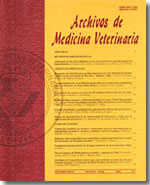Perineal hernia in the dog, a prevalence study of 81 cases
Main Article Content
Abstract
The aim of this is study was to analyse perineal hernia's prevalence in the population, describe its characteristics and to evaluate different surgical techniques used and their results. The study design is a retrospective study of perineal hernia's cases in the Veterinary Teaching Hospital of the University of Extremadura. Perineal hernia cases are 0.96% of the population. Males and females represent 98.2% and 1.2%, respectively. Our population with perineal hernia has an average age of 8,69 years, and a standard deviation of 2.19 years. The average weight body was 16.4 kg ± 11.44 kg. We found 18 bilateral perineal hernias, 40 right unilateral hernias and 20 left unilateral; the total number was 96 perineal hernias. Sixty seven patients underwent surgery, and a total of 80 perineal hernias were repaired. The most frequent clinical signs were perineal bulge and defecation difficulty. Bladder retroflexion appeared in 13.6% of the cases and the prostate was affected in the 21%. It was noted that bilateral perineal hernia patients had increased susceptibility to bladder retroflexion. The techniques used were as follows: anatomical or conventional (7.55%), transposition of the internal obturator muscle (67.92%), anatomical with polypropylene mesh (11.32%), transposition of the internal obturator muscle with polypropylene mesh (13.22%). The transposition of the internal obturator muscle obtained a recurrence's rate of 2.8%. Complications's rate and recurrence's rate on perineal herniorraphy were 9.84% and 14.8%, respectively.

